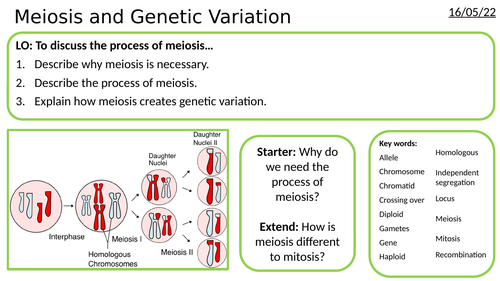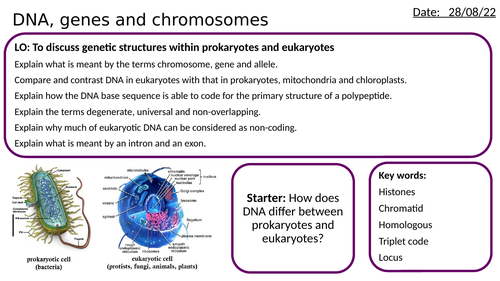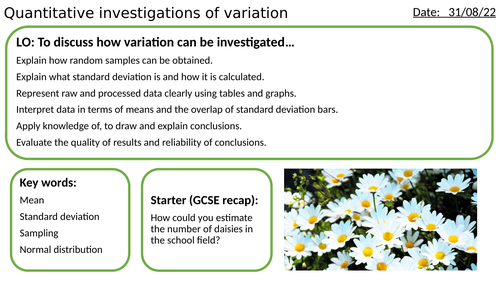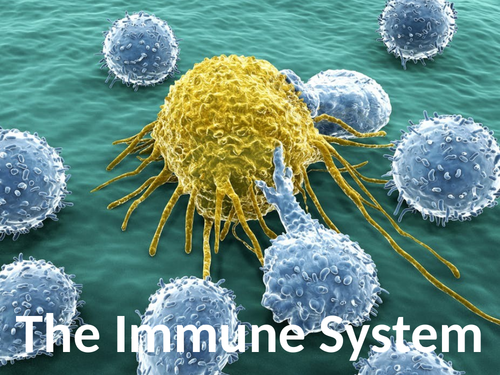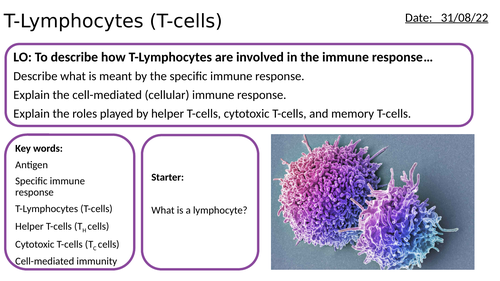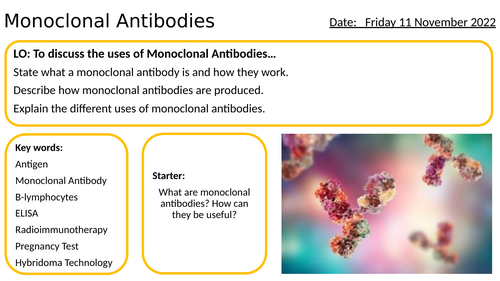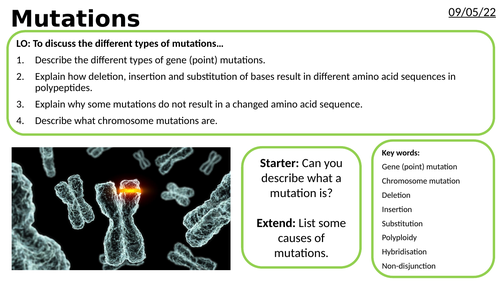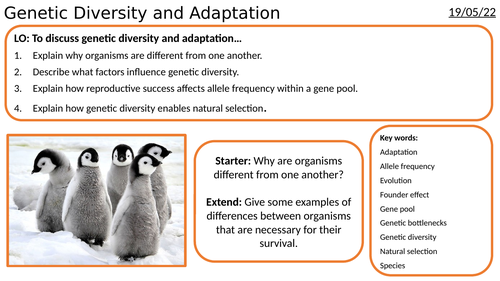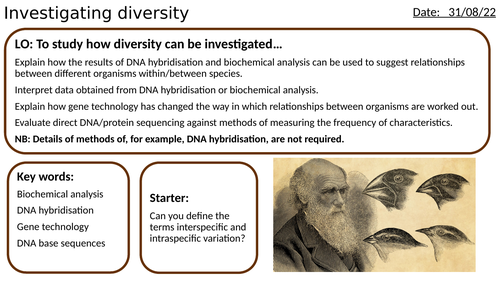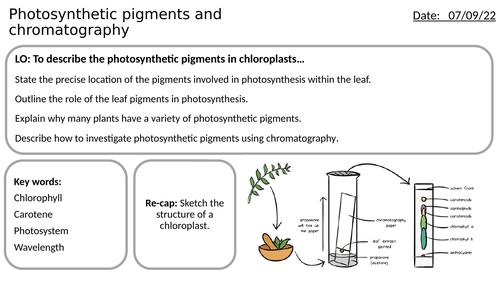79Uploads
21k+Views
15k+Downloads
All resources

AS/A2-Level AQA Biology Meiosis and Genetic Variation Full Lesson
A full 60 minute lesson on Meiosis, covering the following LOs…
Describe why meiosis is necessary.
Describe the process of meiosis.
Explain how meiosis creates genetic variation.
Lesson includes starter task, comprehension task, meiosis diagram sheet, summary questions (and answers), plenary, and also a homelearning task with practice exam questions (and mark scheme).
Bundle

AS/A2-Level AQA Biology - Topic 4: Genetic Information, Variation & Relationships between Organisms *14 LESSON BUNDLE*
AS/A2-Level AQA Biology - Topic 4: Genetic Information, Variation & Relationships between Organisms 14 LESSON BUNDLE
INCLUDES THE FOLLOWING LESSONS…
DNA, genes and chromosomes
Protein synthesis - transcription
Protein synthesis - translation
Gene and chromosome mutations
Meiosis and genetic variation
Genetic diversity and adaptation
The effects of selection
RP6 Investigating selection aseptic technique antibiotics bacterial growth
Classification (phylogeny, taxonomy)
Advances in classification technology
Species (courtship displays/behaviour)
Biodiversity (within a community)
Investigating diversity
Quantitative investigations of diversity
Individual lessons worth £39! Save 33% by buying the bundle.

AS/A2-Level AQA Biology DNA, Genes and Chromosomes Full Lesson
A full 60 minute lesson on DNA, Genes and Chromosomes, covering the following LOs…
Explain what is meant by the terms chromosome, gene and allele.
Compare and contrast DNA in eukaryotes with that in prokaryotes, mitochondria and chloroplasts.
Explain how the DNA base sequence is able to code for the primary structure of a polypeptide.
Explain the terms degenerate, universal and non-overlapping.
Explain why much of eukaryotic DNA can be considered as non-coding.
Explain what is meant by an intron and an exon.
Lesson includes starter task, summary questions (and answers), and practice exam questions (and mark scheme).

GCSE AQA Science Year 10 End of Year Revision Quiz Lesson - Biology, Chemistry and Physics
GCSE AQA Science Year 10 End of Year Revision Quiz Lesson
End of year quiz consisting of 9 rounds of questions on Year 10 science topics (Biology, Chemistry and Physics).
90 questions in total, including answers.

AS/A2-Level AQA Biology Quantitative Investigations of Diversity Full Lesson
A full 60 minute lesson on Quantitative Investigations of Diversity, covering the following LOs…
Explain how random samples can be obtained.
Explain what standard deviation is and how it is calculated.
Represent raw and processed data clearly using tables and graphs.
Interpret data in terms of means and the overlap of standard deviation bars.
Apply knowledge of, to draw and explain conclusions.
Evaluate the quality of results and reliability of conclusions.
Lesson includes starter task, recall questions (and answers), and also practice exam questions (and mark scheme).
Bundle

AS/A2-Level AQA Biology - Topic 2: Cells - Cell recognition and the immune system *8 LESSON BUNDLE*
AS/A2-Level AQA Biology - Topic 2: Cells - Cell recognition and the immune system 8 LESSON BUNDLE
INCLUDES THE FOLLOWING LESSONS…
Antigens and Immunity
Phagocytosis
T-Lymphocytes (Cell-mediated Immunity)
Antibodies
B-Lymphocytes (Humoral Immunity)
Active and Passive Immunity (Vaccination)
Human Immunodeficiency Virus (HIV)/AIDs
Monoclonal Antibodies
Individual lessons worth £21! Save 17% by buying the bundle.

iGCSE Science: Reliability, Accuracy, and Validity Lesson Pack - Evaluating Experimental Data
iGCSE Science: Reliability, Accuracy, and Validity Lesson Pack- Evaluating Experimental Data
Lesson pack designed to help students understand the difference between reliability, accuracy and validity when evaluating experimental data.
Created for iGCSE, but can be easily adapted to suit other exam boards.
Lesson consists of…
Differentiated learning objectives.
RAG starter questions with extension activity, key word handouts, and answers.
Accurate vs. reliable dartboard activity with worksheets.
BIG PHARMA Bingo activity, with bingo statements and 15 bingo cards.
“Would I lie to you?” plenary.
Works really well for Year 9, 10 or 11.

AS/A2 Level Year 12/13 Immune System Immunity Full Lesson Presentation
Presentation covering the following information…
LO1) Describe the physical and chemical (non-specific) defences against pathogens in animals, including the skin, blood clotting, wound repair, inflammation, expulsive reflexes and mucous membranes.
LO2) Describe the structure and mode of action of phagocytes in the non-specific (innate) immune response, including neutrophils and antigen-presenting cells and the roles of cytokines, opsonins, phagosomes and lysosomes.
LO3) Describe the structure, different roles and modes of action of T lymphocytes in the specific (adaptive) immune response, including clonal selection and clonal expansion, T helper cells, T killer cells, T regulatory cells and memory cells.
LO4) Describe the structure, different roles and modes of action of B lymphocytes in the specific (adaptive) immune response, including plasma cells and memory cells.
LO5) Explain the significance of cell signaling, with reference to interleukins.
To accompany my “AS Immune System” Student Revision Booklet Pack (see other resources).

AS/A2-Level AQA Biology T-Lymphocyte T-cell Cell-Mediated Immunity Immune System Full Lesson
A full lesson on T-Lymphocytes, covering the following LOs…
Describe what is meant by the specific immune response.
Explain the cell-mediated (cellular) immune response.
Explain the roles played by helper T-cells, cytotoxic T-cells, and memory T-cells.
Lesson includes starter task, and plenary (application questions and answers).

AS/A2-Level AQA Biology Light independent reaction of photosynthesis Full Lesson
A full lesson on Light independent reaction of photosynthesis, covering the following LOs…
Explain where the light-independent reaction occurs.
Describe the Calvin cycle.
Explain the roles of reduced NADP and ATP.
Interpret experimental data about the light independent reaction.
Lesson includes starter task and practice exam questions (with mark scheme).

AS/A2-Level AQA Biology Biodiversity (within a community) Full Lesson
A full 60 minute lesson on Biodiversity (within a community), covering the following LOs…
Explain what is meant by the terms biodiversity, species richness and index of diversity.
Calculate the index of diversity when supplied with relevant information.
Interpret information and draw conclusions from the index of diversity for different habitats.
Explain how farming techniques impact on biodiversity and the reason why these techniques are used.
Evaluate conservation techniques and why these must be balanced with farming.
Lesson includes starter task, recall questions (and answers), and also practice exam questions (and mark scheme).

AS/A2-Level AQA Biology B-Lymphocyte B-cell Antibodies Humoral Immunity Immune System Full Lesson
A full lesson on B-Lymphocytes, covering the following LOs…
Describe the humoral immune response.
Explain the roles played by B-cells and antibodies.
Explain the difference between the primary and secondary immune response.
Lesson includes starter task, practice exam questions (with mark scheme), and plenary.

AS/A2-Level AQA Biology Monoclonal Antibodies Hybridoma ELISA Pregnancy Test Immunity Full Lesson
A full lesson on Monoclonal Antibodies, covering the following LOs…
State what a monoclonal antibody is and how they work.
Describe how monoclonal antibodies are produced.
Explain the different uses of monoclonal antibodies.
Lesson includes starter task, practice exam questions (with mark scheme), and plenary.

AS/A2-Level AQA Biology Gene and Chromosome Mutations Full Lesson
A full 60 minute lesson on Mutations, covering the following LOs…
Describe the different types of gene (point) mutations.
Explain how deletion, insertion and substitution of bases result in different amino acid sequences in polypeptides.
Explain why some mutations do not result in a changed amino acid sequence.
Describe what chromosome mutations are.
Lesson includes starter task, summary questions (and answers), plenary, and also a homelearning task with practice exam questions (and mark scheme).

AS/A2-Level AQA Biology Genetic Diversity and Adaptation Full Lesson
A full 60 minute lesson on Genetic Diversity and Adaptation, covering the following LOs…
Explain why organisms are different from one another.
Describe what factors influence genetic diversity.
Explain how reproductive success affects allele frequency within a gene pool.
Explain how genetic diversity enables natural selection.
Lesson includes starter task, summary questions (and answers), plenary, and also a homelearning task with practice exam questions (and mark scheme).

AS/A2-Level AQA Biology Investigating Diversity Full Lesson
A full lesson on Investigating Diversity, covering the following LOs…
Explain how the results of DNA hybridisation and biochemical analysis can be used to suggest relationships between different organisms within/between species.
Interpret data obtained from DNA hybridisation or biochemical analysis.
Explain how gene technology has changed the way in which relationships between organisms are worked out.
Evaluate direct DNA/protein sequencing against methods of measuring the frequency of characteristics.
Lesson includes starter task, and practice exam questions (and mark scheme).

AS/A2-Level AQA Biology Chloroplast Structure Full Lesson
A full lesson on Chloroplast Structure, covering the following LOs…
Describe the structure of chloroplasts.
Explain how the structure of a chloroplast is linked to it’s function.
Lesson includes starter task and practice exam questions (with mark scheme).

AS/A2-Level AQA Biology Phagocytosis Phagocyte Non-Specific Immune System Full Lesson
A full lesson on Phagocytosis, covering the following LOs…
Describe the process of phagocytosis.
Explain the role of lysozymes in the destruction of pathogens.
Explain the role of antigen presentation following destruction.
Lesson includes starter task, application questions (with answers), and practice exam questions (and mark scheme).

AS/A2-Level AQA Biology RP6 Investigating Selection Aseptic Technique Antibiotics Bacterial Growth
A PowerPoint on “Investigating Selection” to accompany the Required Practical on Antibiotics & Bacterial Growth (Aseptic Technique), covering the following LO…
Be able to use aseptic techniques to investigate the effect of antimicrobial substances on microbial growth (RP6).
Lesson includes starter task, plenary, home learning task (practice exam questions and mark scheme), and also a student practical sheet (with equipment list, risk assessment, method, extension questions, and teacher marking criteria).
Please check out my other AS/A-Level AQA Biology resources for this topic :)

AS/A2-Level AQA Biology Photosynthetic Pigments and Chromatography Full Lesson
A full lesson on Photosynthetic Pigments and Chromatography, covering the following LOs…
State the precise location of the pigments involved in photosynthesis within the leaf.
Outline the role of the leaf pigments in photosynthesis.
Explain why many plants have a variety of photosynthetic pigments.
Describe how to investigate photosynthetic pigments using chromatography.
Lesson includes starter task, two sets of practice exam questions (and mark schemes), practical questions, and student sheet for Required Practical 7 - Use of chromatography to investigate the pigments isolated from leaves of different plants.

